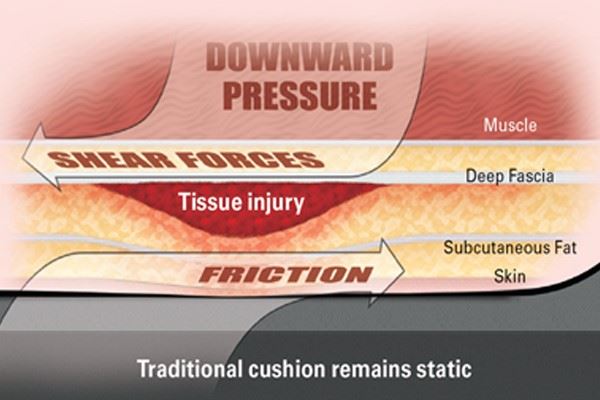-
Home
-
The Benefits of Gel Cushions for Wheelchairs
The Benefits of Gel Cushions for Wheelchairs
July 6, 2023

Individuals who use wheelchairs are at high risk for pressure ulcers and skin breakdown as a result of sitting for long periods of time. These injuries can be incredibly painful and difficult to heal, causing long-term complications and health issues. One of the most effective ways to prevent these injuries is through the use of gel wheelchair cushions.
What is a Gel Cushion?
Gel cushions are specially designed to provide maximum pressure relief and comfort for wheelchair users. The gel distributes weight evenly across the cushion's surface and reduces pressure on bony prominences, helping protect against pressure ulcers and skin breakdown.
What are the Benefits of Gel Cushions for Wheelchairs?
Gel cushions for wheelchairs are designed to reduce the risk of skin breakdown and prevent the development of pressure ulcers caused by prolonged sitting. These cushions offer numerous benefits for individuals who use wheelchairs, including:
- Pressure Relief: Gel cushions are designed to distribute weight evenly across the cushion, reducing pressure on bony prominences and preventing pressure injuries.
- Comfort and Cooling: Gel cushions provide maximum cushioning and support, offering increased comfort for individuals who spend long periods sitting. Unlike traditional foam cushions, gel cushions are also great for temperature regulation and are less likely to trap heat, keeping the patient cool and dry for longer periods of time.
- Reduced Shear: Shear is the force experienced within the tissue as opposing forces move in parallel, which can damage capillaries in the vascular system and lead to pressure injuries. Gel cushions can mimic fatty tissue, moving with the skin to minimize the effects of shear.
- Easy to Clean: Unlike other cushion materials, such as memory foam, gel cushions are easy to clean and maintain—simply wipe them down with a damp cloth or disinfectant. Many gel cushions also have a removable cover that can be washed and sanitized between uses.
How Long Do Gel Wheelchair Cushions Last?
The lifespan of a gel cushion depends on several factors, including how often it is used, the weight of the user, and the quality of the cushion. Generally, gel cushions can last anywhere from two to five years.
To ensure the longevity of your gel cushion, make sure to follow manufacturer guidelines for cleaning and maintenance and monitor the cushion for signs of wear and tear. It is also important to ensure that the cushion is positioned properly in the chair.
Which is the Best Gel Cushion for a Wheelchair?
There are many different brands and types of gel cushions available, each with its unique features and benefits. Some are made of solid gel, while others have multiple layers that provide additional support and pressure relief. When choosing a wheelchair cushion, the best option for you depends on your specific needs and preferences.
AliMed® T-Gel™ Wheelchair Cushions are excellent for applications that require minimal thickness. Low-profile T-Gel is made of a soft, rubber-like elastomer gel that mimics skin-protecting fatty tissue, moving with the skin to minimize the effects of friction and shear while reducing the formation of pressure injuries.
AliMed® T-Gel™ Plus Wheelchair Cushions combine the benefits of T-Gel™ with slow-recovery T-Foam™ for even better pressure distribution and shear reduction. Alitane® envelope protects the T-Foam from incontinence.
AliMed® Coccyx Wheelchair Cushions with Checkerboard T-Gel™ Topper feature a scooped-out area to alleviate pressure on the coccyx, T-Gel™ to help greatly reduce shear forces, T-Foam™ memory foam to reduce pressure, and a built-in Solid Seat Insert™ to help reduce sling seat sag. An integrated wedge cushion also helps reduce forward sliding.
AliMed offers a wide range of gel wheelchair cushions to fit your individual needs and budget—from economical to premium.
Gel vs. Memory Foam
Gel cushions and memory foam cushions are two of the most popular types of wheelchair cushions on the market. Both types of cushions offer pressure relief and support for individuals who spend long periods sitting, but there are some key differences between them.
Memory foam cushions can be more affordable and offer a higher level of customization to the patient's body, providing excellent support and cushioning. However, memory foam can be prone to heat buildup, which can lead to skin irritation and discomfort. Foam also tends to bottom out over time, so these cushions may need to be replaced more frequently.
Gel cushions are often preferred by patients who are prone to developing pressure sores, as they offer a higher level of weight distribution and pressure relief. They also generally keep their shape over time, giving them a longer lifespan than most foam models. Gel cushions are usually heavier than other options, however, and may not be suitable for those with limited upper body strength.
Investing in Comfort and Safety
Gel cushions are an excellent choice for individuals who use wheelchairs and spend long periods sitting down. These cushions provide maximum pressure relief, reduce the risk of pressure ulcers and skin breakdown, and are easy to clean and maintain. By investing in a gel cushion for your wheelchair, you can increase overall comfort and reduce the risk of long-term complications or injuries that may occur due to prolonged sitting.